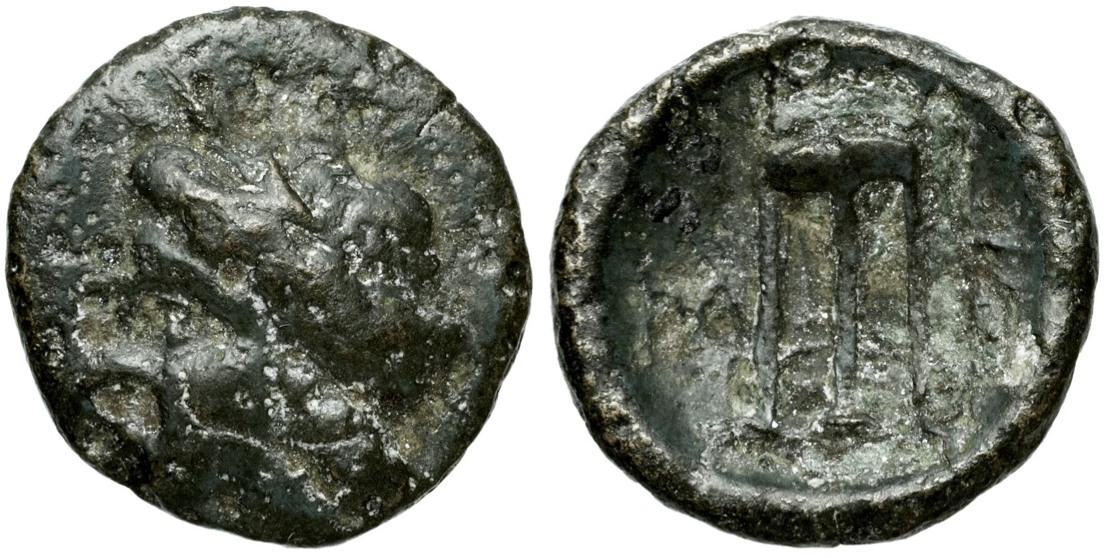RQEM ad. 438 - Messene, bronze, chalkoi (400-200 BCE)
From SILVER
400 BCE - 200 BCE Bronze
Description
| ObverseInscription or printing placed on the obverse.: | Head of Demeter left, wearing earring, necklace and ear and leaves wreath. |
| ReverseInscription or printing placed on the reverse.: | ME (Greek).Tripod with three handles. (In the field, O or Θ.) |
Mint and issuing power
| MintIdentifies the place of manufacture or issue of a numismatic object.: | Messene | Ancient regionAncient region.: | Peloponnesus | Modern countryModern country: Greece | AuthorityIdentifies the issuing power. The authority can be "pretended" when the name or the portrait of X is on the coin but he/she was not the issuing power. It can also be "uncertain" when there is no mention of X on the coin but he/she was the issuing power according to the historical sources: | Messenian League |
Chronology
| FromIdentifies the initial date in a range assigned in a numismatic context. | 400 BCE | toIdentifies the final date in a range assigned in a numismatic context.. | 200 BCE | PeriodTime period of the numismatic object.: Classical and Hellenistic |
Physical description
| MetalThe physical material (usually metal) from which an object is made.: | Bronze |
Median weightMedian of the weights of numismatic objects (in grams). in grams | 2.60 | DenominationTerm indicating the value of a numismatic object. Examples: tetradrachm, chalkous, denarius.: | chalkous |
StandardStandard.: |
Image

RQEM_ad_438.png "Paris, BnF, Fonds général 1756 (https" has not been listed as valid URI scheme.[Paris, BnF, Fonds général 1756 (https://gallica.bnf.fr/ark:/12148/btv1b8569800h)]
References
| Die study referencePublication of the study: | Grandjean 20031Grandjean 2003, series V | ||
| Coin series referenceReference to coin series study: | |||
Obverse dies distribution
| FrequencyFrequency of specimen in distribution. ᵖ | Number of obversesNumber of obverse dies. ᵖ (o) | % (o) | Number of coinsNumber of coins. (n) | % (n) | Die nameName(s) of the die(s). |
| 1 | 10 | 71.43 | 10 | 55.56 | 21, 23, 24, 27, 28, 29, 31, 32, 33, 34 |
| 2 | 4 | 28.57 | 8 | 44.44 | 22, 25, 26, 30 |
| Total | 14 of 14 | 100 | 18 of 18 | 100 |
Reverse dies distribution
no distribution is available
Quantification
| Number of obversesNumber of obverse dies. ᵖ (o) | 14 | Number of singletons (o1)The number of singleton coins. ᵖ | 10 |
| Number of reverse diesNumber of reverse dies. (r) | 16 | Number of coinsNumber of coins. (n) | 18 |
| Coins per obverse dieNumber of coins per obverse die. (n/o) | 1.29 | Coins per reverse dieNumber of coins per reverse die. (n/r) | 1.13 |
| Reverse per obverse ratioRatio of obverse dies divided by reverse dies. (r/o) | 1.14 | Percentage of singletons (o1)number of coins (n) divided by the number of singletons (o1) ᵖ | 71.43 % |
| Original number of dies (O) (Carter 1983 formula)The estimation of the number of coins according to Carter 1983 ᵖ | 49.47 | Coins struck if 20,000 as average productivity per dieCoins made if the average productivity for obverses (according to Carter) is 20,000. ᵖ | 989,400 |
| Original number of dies (O) (Esty 2011 formula)The estimation of the number of coins according to the singleton formula in Esty 2011 ᵖ (O) | 63 | Survival rate if 20,000 as average productivity per dieSurvival rate if average productivity is 20,000. ᵖ | 0.00002 |
| Coverage (o = % of O) (Esty 1984 formula)Esty 1984 - coverage (% of O) ᵖ (o = % of O) | 44.44% | Die productivity if survival rate 1/2,000Average productivity if survival rate is 1/2,000. ᵖ | 727.71 |
| Weight of silver (in kg) if 20,000 coins per die (O = Carter formula)Carter 1983 * Median weight * 20000 (*10 if gold or electrum) ᵖ | n.a. | Die productivity if survival rate 1/5,000Average productivity if survival rate is 1/5,000. ᵖ | 1,819.28 |
Remarks
Metrology boards, p. 40.